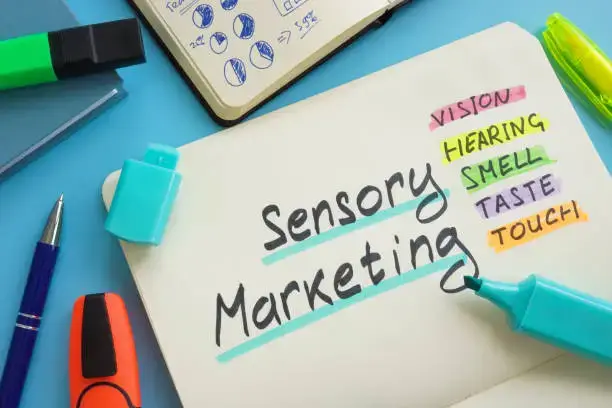
Sensory marketing is an emerging trend that has gained significant attention from marketers in recent years. This strategy aims to enhance the sensory experience of consumers with the objective of influencing their behavior toward a product or service.
This employs a combination of visual, auditory, olfactory, and tactile stimuli to create an emotional and memorable experience for the consumer. The impact of this on consumer behavior has been a subject of interest among marketers, academics, and researchers.
This article aims to provide an in-depth understanding of the impact of sensory marketing on consumer behavior by exploring its theoretical framework, the different sensory marketing strategies, and its impact on consumer behavior.
This article will explore the impact of sensory marketing on consumer behavior, strategies for implementing effective sensory marketing, and the future of sensory marketing. By understanding the power of sensory marketing, businesses can create a unique brand experience that resonates with their customers and drives business growth.
Understanding Sensory Marketing
Sensory marketing is a type of marketing strategy that focuses on engaging the five senses of consumers—sight, sound, smell, taste, and touch—to influence their perception of a brand or product. By appealing to the senses, businesses can create a positive emotional response and establish a memorable brand experience that differentiates them from competitors.
To effectively use it, it’s crucial to have a thorough understanding of how each sense impacts our behavior. For instance, sight is often the first sense we use to form an impression, and it can influence our perception of a product’s quality, value, and aesthetics.
Sound, on the other hand, can evoke certain emotions and create a sense of atmosphere or mood. Taste and smell are particularly relevant in the food and beverage industry, where the sensory experience plays a significant role in consumer satisfaction and loyalty. Lastly, touch can be used to create a tactile experience, which can make a product feel more premium and high-quality.
By utilizing these sensory cues, businesses can create a multisensory brand experience that engages and resonates with consumers. For example, a retail store might use a signature scent to create a unique atmosphere that makes customers feel comfortable and relaxed, while a food and beverage brand might use a combination of taste and smell to evoke feelings of nostalgia and comfort.
In summary, understanding the role of each sense in sensory marketing is critical for businesses to create an effective and memorable brand experience. By doing so, they can build a strong emotional connection with their customers and differentiate themselves from competitors.
What is the Impact on Consumer Behavior?
Sensory marketing has a significant impact on consumer behavior, as it has been shown to influence their perception of products and brands as well as their purchasing decisions. By engaging the senses, businesses can create a positive emotional response that leads to increased sales and customer loyalty.
Studies have shown that sensory cues can affect how consumers perceive the quality, value, and desirability of a product. For example, the use of high-quality materials, unique textures, and pleasant scents can make a product feel more premium and appealing to consumers. Sensory marketing can also create a sense of familiarity and comfort, which can increase brand loyalty and repeat purchases.
In addition to influencing product perception, sensory marketing can also affect purchasing decisions. By creating a multisensory brand experience, businesses can make their products more memorable and stand out in a crowded marketplace. This can lead to increased sales, as consumers are more likely to choose a product that they remember and feel a connection to.
Overall, the impact of sensory marketing on consumer behavior cannot be overstated. By utilizing sensory cues to create a memorable brand experience, businesses can increase sales, build customer loyalty, and differentiate themselves from competitors.
Strategies for Implementing Effective Sensory Marketing
Implementing effective sensory marketing strategies requires a thoughtful and deliberate approach that takes the target audience’s sensory preferences into account. Here are some strategies that businesses can use to create a memorable and impactful sensory experience:
1. Identify the target audience and their sensory preferences: It’s important to understand the target audience and what sensory cues they respond to. For example, younger consumers may prefer bold and bright colors, while older consumers may prefer more subtle and classic aesthetics.
Innovative Tech Solutions, Tailored for You
Our leading tech firm crafts custom software, web & mobile apps, designed with your unique needs in mind. Elevate your business with cutting-edge solutions no one else can offer.
Start Now2. Use sensory cues to create a memorable brand experience: Once the target audience has been identified, businesses can use sensory cues to create a unique brand experience. This could include using a signature scent, playing music that evokes certain emotions, or using tactile materials that make a product feel premium.
3. Create a consistent sensory experience across different channels: It’s important to create a consistent sensory experience across different touchpoints, such as in-store, online, and social media. This can help reinforce the brand experience and make it more memorable for consumers.
4. Experiment and test different sensory cues: Not all sensory cues will work for every business or audience. It’s important to experiment and test different sensory cues to see what resonates with customers and what doesn’t.
By implementing these strategies, businesses can create a memorable and impactful sensory experience that resonates with their target audience and drives sales and brand loyalty. It’s important to remember that effective sensory marketing requires a thoughtful and deliberate approach that takes into account the unique needs and preferences of the target audience.
Read: Dealing with Client Questions on Project Delays
The Future of Sensory Marketing
The future of sensory marketing is bright, as technology and innovation continue to push the boundaries of what’s possible. Here are some of the trends and developments that we can expect to see in the coming years:
1. The rise of virtual and augmented reality: Virtual and augmented reality technologies allow businesses to create immersive sensory experiences that transport customers to a different world. For example, a furniture retailer could use VR technology to create a virtual showroom that allows customers to see and touch products before making a purchase.
2. Personalization and customization: As technology becomes more advanced, businesses can use data and artificial intelligence to create personalized sensory experiences for individual customers. For example, a restaurant could create a menu that’s tailored to each customer’s taste preferences based on their previous orders.
3. Sustainability and eco-friendliness: As consumers become more environmentally conscious, businesses can use sensory cues to highlight their commitment to sustainability and eco-friendliness. This could include using natural materials, creating a relaxing atmosphere that emphasizes the natural world, or using a signature scent that evokes a sense of freshness and cleanliness.
4. Integration with other technologies: Sensory marketing is likely to become increasingly integrated with other technologies, such as voice assistants, wearables, and smart home devices. For example, a smart home device could use sensory cues to create a relaxing atmosphere when a customer arrives home after a long day.
Overall, the future of sensory marketing is exciting and full of possibilities. By leveraging technology and innovation, businesses can create memorable and impactful sensory experiences that resonate with customers and drive sales and brand loyalty.
Conclusion
As businesses continue to compete in a crowded marketplace, incorporating sensory marketing into their strategies can be a game-changer. By engaging the senses, businesses can create a memorable and impactful brand experience that resonates with customers and sets them apart from competitors.
Therefore, I urge businesses of all sizes and industries to consider incorporating sensory marketing into their strategies. Whether it’s using a signature scent, creating a multisensory in-store experience, or experimenting with virtual and augmented reality, there are endless possibilities for businesses to leverage sensory cues to create a unique and memorable brand experience.
The future of sensory marketing is exciting and full of potential. As technology continues to advance, businesses have more opportunities than ever to create immersive and personalized sensory experiences that resonate with customers and drive sales and brand loyalty.
However, it’s important to remember that effective sensory marketing requires a thoughtful and deliberate approach that takes into account the unique needs and preferences of the target audience. Businesses that can successfully incorporate sensory marketing into their strategies will be well-positioned to succeed in a rapidly evolving marketplace.
In conclusion, sensory marketing is a powerful tool that businesses can use to create a memorable and impactful brand experience. By staying up-to-date on the latest trends and developments in the field, businesses can position themselves for success now and in the future.
Before you go…
Hey, thank you for reading this blog to the end. I hope it was helpful. Let me tell you a little bit about Nicholas Idoko Technologies. We help businesses and companies build an online presence by developing web, mobile, desktop, and blockchain applications.
We also help aspiring software developers and programmers learn the skills they need to have a successful career. Take your first step to becoming a programming boss by joining our Learn To Code academy today!
Be sure to contact us if you need more information or have any questions! We are readily available.










